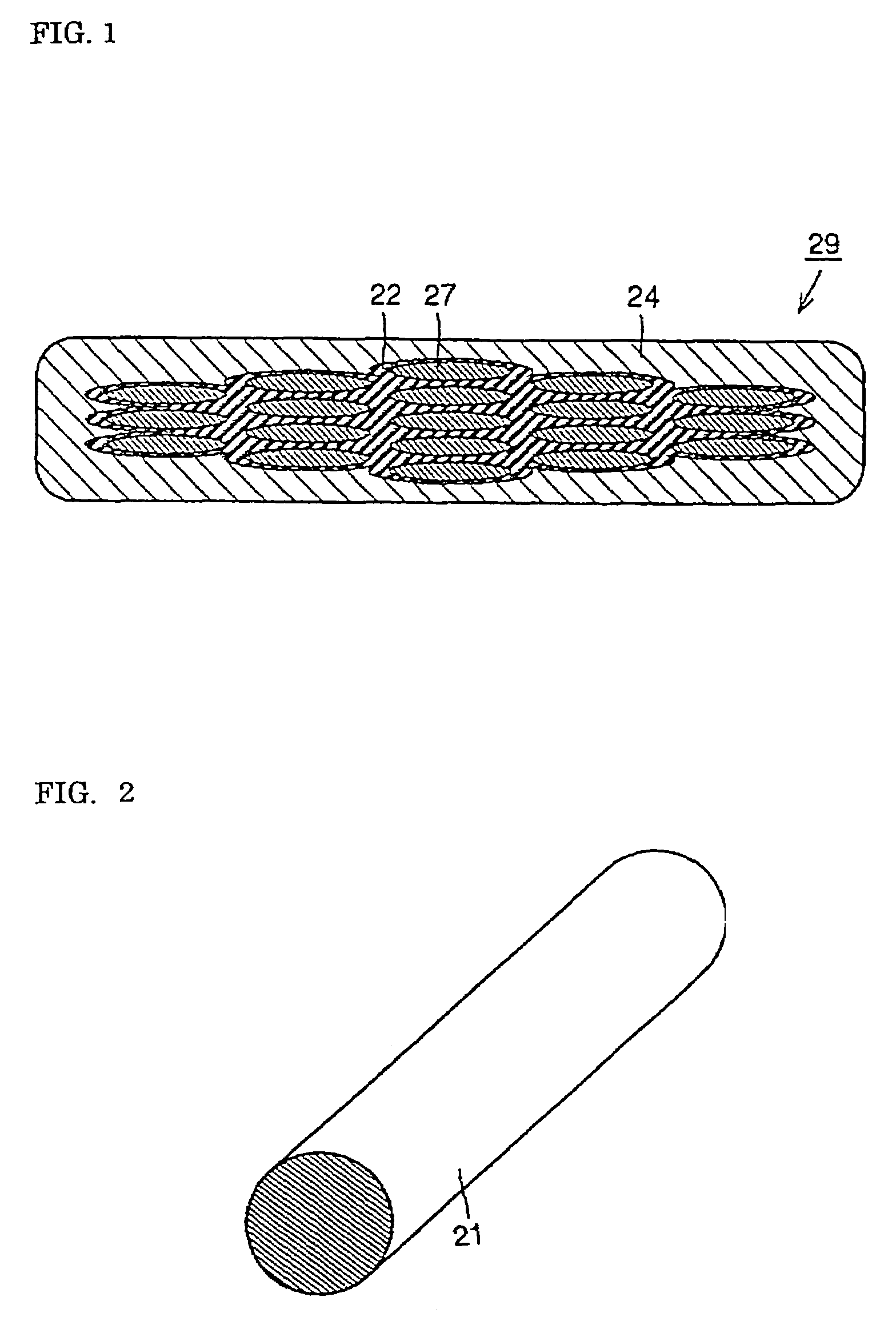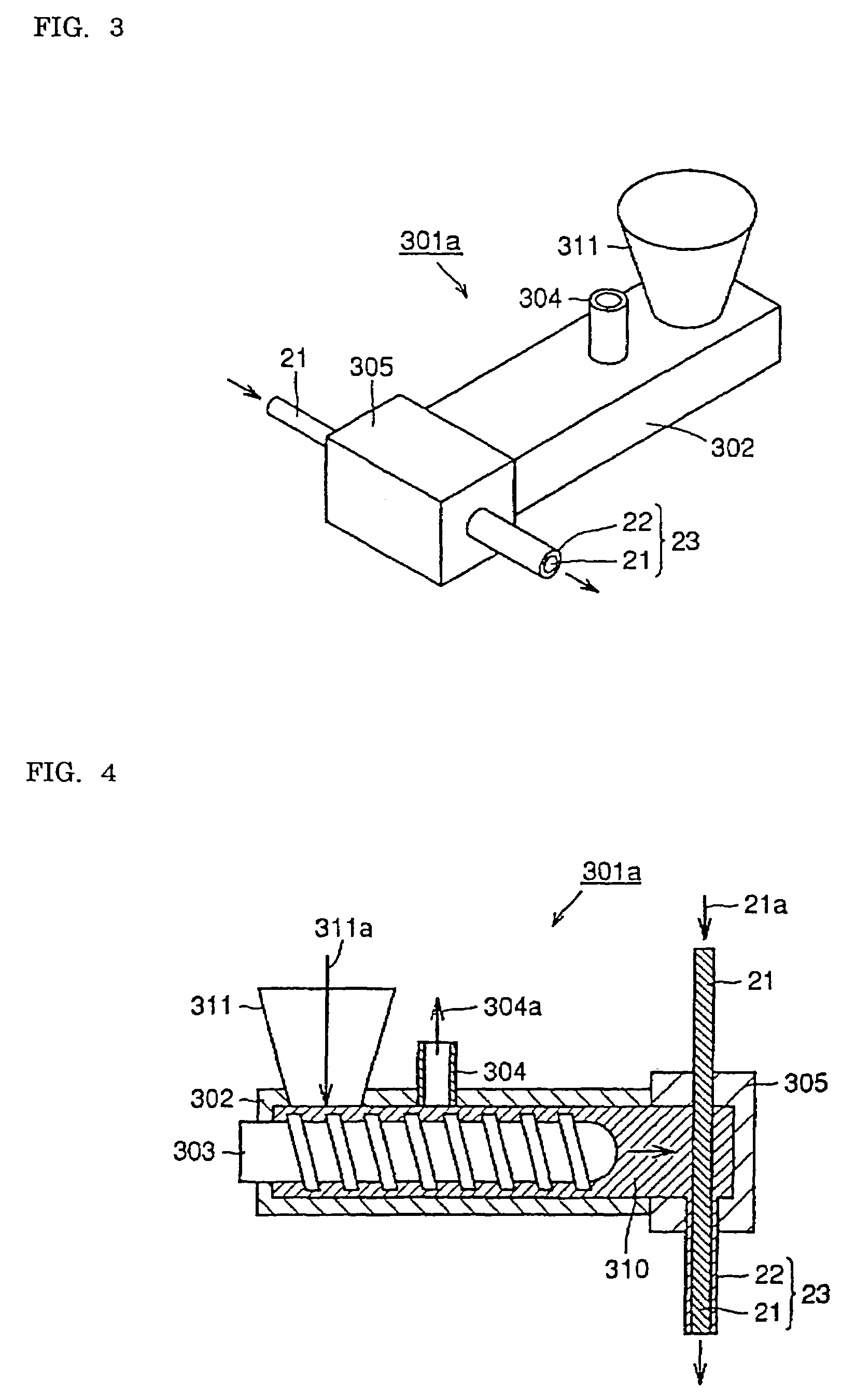Oxide high-temperature superconducting wire and method of producing the same
a superconducting wire and high-temperature technology, applied in the direction of superconducting magnets/coils, magnetic bodies, natural mineral layered products, etc., can solve the problems of insufficient reduction of ac loss, difficult to make such barriers with a uniform density and thickness in limited spaces, and difficult to increase the perpendicular resistance between, so as to reduce ac loss
- Summary
- Abstract
- Description
- Claims
- Application Information
AI Technical Summary
Benefits of technology
Problems solved by technology
Method used
Image
Examples
embodiment 1
[0112]FIG. 1 shows a cross section of an oxide superconductor wire produced in accordance with the first embodiment of the present invention. The oxide superconducting wire 29 comprises oxide superconducting filaments 27, a ceramic layer 22, and a silver sheath 24 as a metal pipe. Each of the superconducting filaments 27 is in contact and coated with the ceramic layer 22. The ceramic layer 22 containing a metal oxide becomes non-conductive at an operating temperature of the filaments 27. The ceramic layer 22 is in contact and coated with the silver sheath 24. The oxide superconducting wire 29, which is formed into a tape, extends from an end whose sectional view is illustrated in FIG. 1 toward the other end not illustrated herein. The filaments 27, the ceramic layer 22, and the silver sheath 24 have flat structures elongated laterally. The filaments 27 consist of, for example, (Bi, Pb)2 Sr2 Ca2 Cu3Ox. The oxide superconducting wire 29 contains a plurality of the filaments 27. The fi...
embodiment 2
[0119]FIG. 8 is a cross section of an oxide superconducting wire produced in accordance with the second embodiment of the present invention. The oxide superconducting wire 39 comprises oxide superconducting filaments 37, a ceramic layer 31, and a silver sheath 34 as a metal pipe. The filaments 37 are each in contact and coated with the ceramic layer 31, which become non-conductive when the filaments 37 are cooled to an operating temperature. The ceramic layer 31 is in contact and coated with the silver sheath 34. The oxide superconducting wire 39 is a tape shape extending from the end whose cross section is shown in FIG. 8 toward the other direction not illustrated herein. The filaments 37, the ceramic layer 31 and the silver sheath 34 are formed into tape-shaped structures having a flat cross-section elongated laterally. The filaments 37 consist of, for example, (Bi, Pb)2 Sr2 Ca2 Cu3Ox. The oxide superconducting wire 39 includes a plurality of the filaments 37 which are each surrou...
embodiment 3
[0126]FIG. 15 is a cross section of an oxide superconducting wire produced in accordance with the third embodiment of the present invention. The oxide superconducting wire 49 comprises oxide superconducting filaments 47, a ceramic layer 48, and a silver sheath 44 as a metal pipe. The filaments 47 are each in contact and coated with the ceramic layer 48, which become non-conductive when the filaments 47 are cooled to an operating temperature. The ceramic layer 48 is in contact and coated with the silver sheath 44. The oxide superconducting wire 49 is a tape shape extending from the end whose cross section is shown in FIG. 15 toward the other direction not illustrated herein. The filaments 47, the ceramic layer 48 and the silver sheath 44 are formed into tape-shaped structures having a flat cross-section elongated laterally. The filaments 47 consist of, for example, (Bi, Pb)2 Sr2 Ca2 Cu3 Ox. The oxide superconducting wire 49 includes a plurality of the filaments 47 which are each surr...
PUM
| Property | Measurement | Unit |
|---|---|---|
| thickness | aaaaa | aaaaa |
| thickness | aaaaa | aaaaa |
| frequency | aaaaa | aaaaa |
Abstract
Description
Claims
Application Information
 Login to View More
Login to View More - R&D
- Intellectual Property
- Life Sciences
- Materials
- Tech Scout
- Unparalleled Data Quality
- Higher Quality Content
- 60% Fewer Hallucinations
Browse by: Latest US Patents, China's latest patents, Technical Efficacy Thesaurus, Application Domain, Technology Topic, Popular Technical Reports.
© 2025 PatSnap. All rights reserved.Legal|Privacy policy|Modern Slavery Act Transparency Statement|Sitemap|About US| Contact US: help@patsnap.com



